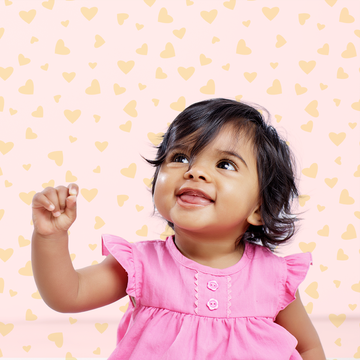It was a warm summer morning and I was folding a mountain of laundry on our screened-in porch. I was listening to a podcast with the volume turned up to drown out my 3-month-old daughter, who was screaming while fighting nap time. My whole body tensed with every sound she made. I was exhausted. I reassured myself her fussiness was normal, but, inside, I silently screamed just as loudly and intensely as she did.
The podcast was a random one on parenting I found on Spotify, but the host said something in that moment that would change my perspective on motherhood forever: “Mastrescence is as intense as adolescence.”
I’d never heard the term “mastrescence” before, but it immediately clicked. Just like adolescence marks the hormonal, emotional and social transition from childhood to adulthood, matrescence is the physical, psychological and frankly spiritual transformation someone goes through when they become a mother. It’s not just sleep deprivation or the baby blues, it’s a total redefinition and reorganization of self.
Stunned at this eloquent, succinct way to describe the identity shift I felt, growing to a mother responsible for another human, I somehow found it comforting to know it wasn’t all in my head. It was an experience every new parent experienced and endured.
While I was well-educated and prepared during pregnancy on what to put on my baby registry, where to book my birthing class and screened every two weeks with ultrasounds and testing — there is far less focus on postpartum. Or the post-birth recovery. Or the emotional maelstrom that so many women endure afterwards. What surprised me the most about this realization is that while the challenges of pregnancy, birth and postpartum have always existed, the scientific community has only recently begun to try to understand them better.
“Matrescence is in its early stages of being studied, however, we know that the process of giving birth and the transition to parenthood are only the beginning,” explains Dr. Jessica Vernon, M.D., author and the associate medical director and director of mental health at Oula. “We know that many of the physiological changes that occur during pregnancy and in the postpartum period are not temporary.”
I know from experience that becoming a mom fundamentally changes who you are from the inside out. My difficult early period with my first daughter — ripe with postpartum anxiety and depression — inspired me to lean heavily into the study of ‘mastrescence’ and to better advocate for myself and other new mothers in this delicate time. The transition to motherhood isn’t just about sleepless nights and diaper changes; it’s a complete identity shift, both biologically and emotionally. (This is part of the reason I founded Mila & Jo Media, a content marketing agency that helps brands better connect to mothers.)
Scientists say this transformation is similar to adolescence because of hormonal changes, brain rewiring, and an evolving sense of self. "During this time, a woman experiences shifts in her hormones and in her environment that lead to lasting changes in her brain and body," says Brunilda Nazario, M.D., the Chief Physician Editor, Medical Affairs, at WebMD. "These changes are permanent neurological and biological changes in a woman that experts believe prepare a women for motherhood." So why do we treat it as just a phase instead of a major life transition? Here, what you need to know about matrescence if you’re about to become a mom — or want to support someone in your life who is expecting.
It’s not just "baby blues" — it’s your hormones.
Immediately following birth and for the first few days of a child’s life, some women experience a feeling of sadness mixed with nostalgia and homesicknesses, usually called the ‘baby blues.’ This is largely due to the dramatic hormone shift that happens immediately — where sky-high hormones that support a healthy pregnancy dramatically fall to a level as low as menopause. This cute nickname for a very challenging experience is actually the start of matrescence, and should be given as much credit as puberty.
Chelsey Scaffidi, a matrescence educator and author of the newly released book The Mother Year, says that while adolescence is widely recognized and supported as a developmental milestone, matrescence has often gone unnamed and unacknowledged, despite being just as biologically and psychologically significant.
In fact, she shares recent research suggesting the neurological and hormonal changes of matrescence may even surpass those of puberty in both scope and intensity. Researchers go as far as to say matrescence initiates a "rapid and extreme physiological transformations that are unparalleled across the lifespan.”
In other words, becoming a mother is a hormonal and full-body experience that only competes with puberty and menopause. As Scaffidi puts it, “What follows is an exploration of these powerful changes and how they shape the maternal brain, body, and sense of self.” Specifically, these hormones are at play:
Estrogen and Progesterone: During adolescence, estrogen and progesterone steadily increase to support the onset of menstruation and sexual development. In pregnancy, however, these same hormones spike to levels more than 100 times higher than those seen during puberty. After childbirth, they crash almost immediately — within days — triggering intense emotional shifts that often resemble, but surpass, the mood swings of PMS. “These dramatic hormonal swings can also affect cognition and emotional regulation, echoing but exceeding the hormonal turbulence of adolescence,” Scaffidi says.
Oxytocin: “Known as the bonding hormone, oxytocin plays a social role in both stages: fueling peer bonding in teens and maternal bonding in new mothers,” Scaffidi says. “Mothers can stimulate oxytocin production via skin-to-skin contact to enhance maternal sensitivity and emotional connection. While teens receive oxytocin boosts from social interactions, new mothers experience some of the most intense oxytocin peaks of their lives in the days and weeks following childbirth.”
Prolactin: While Scaffidi says this hormone doesn’t get much spotlight in adolescence, in matrescence, prolactin becomes a star player. “Prolactin surges in late pregnancy and especially after birth, particularly if breastfeeding, to stimulate milk production,” she explains. “But prolactin isn’t just about milk; it also has behavioral effects.” In animal studies, this hormonal shift is key in promoting maternal behaviors, such as nurturing and protecting offspring. In humans, new mothers often feel an overwhelming urge to "baby gaze" or become deeply preoccupied with their infant’s well-being. Unlike adolescence — where the body is not biologically primed for caregiving — this caregiving instinct is uniquely activated in the postpartum period. So, it’s reasonable to say you are more hormonal after birth than during puberty since more hormones are at play.
No, it’s not mommy brain — it’s a complete rewire of your cognition function.
Sometimes, new sleep-deprived and healing mothers are teased for having ‘mommy brain’ when they are forgetful or perhaps can’t keep 100 balls spinning in the air at the same time. Though it was once considered a temporary experience that improves over time, recent research has indicated that becoming a mom does, in fact, permanently rewire your brain.
“Pregnancy, birth, and early motherhood reshape the brain in ways that are both profound and long-lasting, structurally, functionally, and emotionally,” Scaffidi says. “These changes aren’t just temporary adjustments; they’re part of a full-body, full-brain transformation that equips mothers for the work of caregiving.”
A 2025 study used MRI to track brain changes in 179 first-time gestational mothers and found that gray matter volume shrank by 4% to 5% across 94% of the brain — most notably in regions tied to social cognition. While some of that volume began to rebound by six months postpartum, the changes weren’t fully reversed.
While this may seem daunting — and perhaps a little scary! — researchers don’t see it as a downfall or a silly ‘mommy brain’ symptom but as a benefit. “Rather than being a loss, these reductions are thought to reflect the brain becoming more efficient: essentially reorganizing itself to prioritize maternal responsiveness and attunement,” Scaffidi says.
Rapid postpartum changes have also been observed in the amygdala, hippocampus and prefrontal cortex. A 2024 study shows these areas shift dramatically within the first six weeks postpartum. “While some changes rebound, others persist, and the degree of brain restructuring has been linked to more positive maternal feelings, suggesting that these transformations are deeply tied to the emotional experience of becoming a mother,” Scaffidi explains.
Functionally, the brain’s connectivity also evolves: another 2024 study illustrated the maternal brain continues adapting for at least six months postpartum. Some changes in the brain’s emotional centers seem to track with hormonal shifts — such as the steep drop in progesterone after birth — while others appear to be shaped by experience itself. The repeated rhythms of feeding, soothing and holding a baby may actively rewire the brain in real time.
This is echoed in a 2023 study that found a mother’s ability to multi-task, express empathy and regulate her emotions improve over time, a process called "adaptive neuroplasticity," which may explain the so-called mom brain. “From that perspective, what feels like forgetfulness or scatter may actually be the brain reprioritizing: tuning out what’s nonessential in favor of deep presence and survival-level attunement to a newborn,” Scaffidi says. “The more we understand the maternal brain, the clearer it becomes: These changes are not flaws or side effects. They’re purposeful. They’re part of the architecture of motherhood, designed to support the incredible work of nurturing new life.”
It’s not all biology — it’s experiential.
It’s important to note matrescence doesn’t just pertain to those who have been pregnant and given birth; adoptive mothers also experience a transformation. While Scaffidi says adoptive parents may not go through the hormonal shifts of pregnancy, they still undergo a significant shift in identity, anxiety, stress and even post-adoption depression, which can mirror postpartum experiences.
Plus, bonding with their child triggers hormonal responses like increased oxytocin, and they endure similar challenges of sleep deprivation, social isolation and the steep learning curve of early parenthood. Though the path looks different, the impact is just as real and worthy of recognition.
Most research on maternal brain changes has focused on women who give birth, but emerging studies suggest that adoptive mothers also experience meaningful functional and hormonal adaptations. For example, nurturing interactions raise oxytocin levels in adoptive mothers, supporting bonding behaviors similar to those seen in biological mothers.
Scaffidi notes while it’s still unclear if adoptive mothers undergo the same structural brain changes, the evidence shows that the emotional and relational experience of caregiving activates maternal systems in the brain — highlighting that the transformation into motherhood is deeply experiential, not just biological.
Why naming ‘matrescence’ as a distinct developmental stage rather than just a temporary adjustment can normalize the experience.
Though I’ve been to therapy throughout my life for different reasons and triggers, like the passing of my father, nothing has compared to how lost I felt when I became a mother for the first time. I didn’t feel at home in my postpartum body. I didn’t recognize myself when I looked in the mirror and, well, I had no idea how to not only take care of this new, fragile baby…or myself. My therapist helped me to recognize my feelings as a period of mourning. I could love my child, and miss my life. I could feel so lucky, and I could grieve. These two things could be true.
Scaffidi says the term “matrescence” itself was coined to underscore this parallel when anthropologist Dana Raphael introduced the word, and Athan later revived and expanded it, emphasizing that just as we have a word for the transition into adulthood — adolescence — we also need one for the transition into motherhood.
“Naming it helps us normalize it,” Scaffidi says. “When mothers understand what they’re experiencing, they’re less likely to feel alone or ‘broken.’ It makes sense that matrescence brings a complex blend of emotions: joy, grief, excitement and anxiety. Many women grieve the freedom and identity they left behind, even as they embrace the new. Much like a teenager may long for the simplicity of childhood while yearning for adult independence, mothers often find themselves suspended between who they were and who they are becoming.”
I welcomed my second daughter in late 2024, and at almost five months postpartum, I can undoubtedly say this transition was infinitely easier than the first. My brain had already been rewired and attuned to the balancing act of being a mother, a human, a wife, a friend and a professional. My hormones were already tied up into the big needs of tiny humans. My heart was already prepared for the breaking-open it was about to experience again.
And perhaps, most importantly, I had a term, a definition, a lived experience and a word to label my continued transformation into motherhood: matrescence.
Knowing that what I was feeling had a name made all the difference. It allowed me to give myself more grace, recognize the growing pains for what they were and see the beauty in the becoming, not just of my children but of myself. Matrescence didn’t end after the first or second baby — it’s an ongoing universal evolution. It's who I am now, and I see it in my mother, my grandmother, and all of my friends who take this journey.
Through them and myself, I own ‘matrescence’ with awareness, acceptance — and maybe even a little awe.

Lindsay Tigar is a national freelance journalist and the co-founder of Mila & Jo Media, media and coaching company providing mother-first, expert-backed and community-centered content and resources. Her work has appeared in USA Today, National Geographic, Vogue, CNN, Time, Real Simple, and countless other publications. A full collection fo her writing can be found at LindsayTigar.com.

Brunilda Nazario, M.D. is the Chief Physician Editor, Medical Affairs, at WebMD.

















